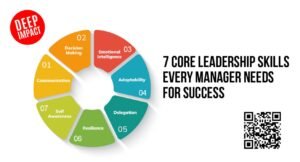Leadership has always been about moving people towards a common goal, but the way this is achieved has changed dramatically over the years. In the past, positional authority was often enough to secure compliance. Today, however, authority on its own is no longer sufficient. Modern workplaces demand collaboration, autonomy, and meaning. Leaders who rely on pressure and control quickly discover the limits of authority. The more effective path is influence—an approach that does not push people forward but draws them into a shared vision.
The Limits of Authority-Driven Leadership (and Why It Fails Buy-In)

Authority-driven leadership often appears to work in the short term. Teams may deliver results out of fear of consequences or respect for hierarchy. Yet this compliance comes at a cost:
* Creativity is stifled because people do only what is asked
* Engagement declines as individuals feel they have little control over their work
* Collaboration weakens since competition and defensiveness take over
* Long-term performance suffers because motivation is external, not internal
Leaders who keep pushing harder may see temporary improvements but eventually face disengagement, turnover, and burnout. Authority secures obedience, not ownership.
Influence vs. Pressure: What Actually Drives Commitment at Work
Influence, in contrast, works at a deeper level. It is not about demanding effort but inspiring commitment. Influence connects people to meaning and draws out their best contributions. It makes individuals feel that the work belongs to them, not just to the leader.
Where pressure relies on external control, influence taps into internal motivation. People step up not because they must, but because they want to. This creates resilience and adaptability, especially in uncertain times when energy and creativity are needed most.
Read more: Leadership Strength Lies in Influence, Not Authority
Principles to Create Genuine Buy-In (Trust, Respect, Transparency, Collaboration)
Genuine buy-in is not accidental. It is built through deliberate leadership practices. Some core principles include:
1. Trust – Trust is the foundation of influence. Leaders who deliver on promises, acknowledge mistakes, and act with consistency create a culture where people feel safe to commit.
2. Respect – People are more engaged when they feel valued. Listening, seeking input, and involving team members in decisions communicates respect and builds ownership.
3. Transparency – Explaining the ‘why’ behind decisions fosters understanding and reduces resistance. Clarity creates confidence.
4. Collaboration – Inviting people into the process, rather than dictating outcomes, turns them into co-creators instead of passive executors.
When these principles are practised consistently, teams begin to invest emotionally in outcomes.
Read more: Integrity and Openness: The Foundations of Reliable Leadership
Vision & Storytelling: How Leaders Win Hearts and Minds
Facts and instructions are rarely enough to move people. Stories, however, connect on an emotional level. Leaders who use storytelling bring vision to life. They help people see how their individual roles contribute to something larger.
For example, a healthcare leader could share stories of how a new initiative transformed patient lives. A technology manager could highlight customer stories where solutions made a real difference. These narratives turn abstract goals into tangible impact.
Vision without storytelling feels distant. Storytelling without vision lacks direction. Together, they create a powerful tool of influence—one that inspires, aligns, and sustains commitment.
Daily Habits of Influential Leaders (with Examples & Scripts)
Influence is not built in a single conversation. It emerges from daily habits, repeated consistently. Some practical habits include:
- Showing appreciation: Regularly thanking people for their contributions, however small, builds motivation and loyalty
- Explaining decisions: Sharing the reasoning behind choices increases transparency and trust
- Modelling behaviour: Demonstrating calmness, respect, and solution-focused thinking sets the tone for others to follow
- Admitting limitations: Leaders who acknowledge what they do not know display humility, which strengthens credibility
- Consistent follow-through: Keeping promises, even in small matters, reinforces dependability
Over time, these practices create a culture where trust is strong, voices are heard, and accountability is shared.
Also Read: Unlock the 7 Levels of Leadership to Create High-Performing Teams
From Compliance to Commitment: A Playbook You Can Use Monday
The contrast between pressure and influence is stark:
- Pressure produces compliance – people do what is required to stay safe
- Influence produces commitment – people bring their creativity, ideas, and energy because they feel ownership
This shift has a profound impact. Teams led by influence are more resilient, proactive, and collaborative. They anticipate challenges instead of merely reacting to them. They innovate rather than follow. And they remain motivated even in times of disruption because their commitment is anchored in meaning rather than fear.
Influence Beats Authority for Lasting Buy-In
Leading with influence is about moving beyond the limitations of authority. Pressure may secure obedience, but it does not inspire. Influence, grounded in trust, respect, and vision, creates genuine buy-in. It invites people into the process and helps them see how their work matters.
The leaders who embrace this approach discover they no longer need to push as hard. Their teams are already leaning forward, motivated not by pressure but by purpose. This is the true measure of leadership in today’s world—not how much authority one holds, but how deeply one can inspire others to act.
Talk to Us About Leadership Training for Managers.
You Might Also Like: Align Leadership Development and Consulting with Your Business Objectives






